Abstract
Anomalies recently observed in semileptonic and transitions point to violation of Lepton Flavour Universality. Strategies for new analyses of different modes are required, in particular for the modes induced by the transition. We describe the purely leptonic B decay, the channel and the B semileptonic modes to and in extensions of the Standard Model involving Lepton Flavour Universality violating operators. In particular, we review the observables in the four-dimensional angular and distributions, suitable to pin down deviations from the Standard Model. We discuss the complementarity among the various modes for New Physics searches.
1. Introduction
Several anomalies have recently emerged in tree-level and in loop-induced semileptonic transitions. In tree-level modes, the measured ratios (with ) [1,2,3,4,5,6,7,8,9] exceed the Standard Model (SM) predictions at [10]. This is remarkable, since the hadronic uncertainties largely cancel out in the ratios [11,12]. The measurement of [13] is also above the (more uncertain) SM expectation [14,15,16,17]. For neutral current semileptonic modes, the ratios , measured in various ranges of the dilepton invariant mass [18,19,20], also deviate from the SM predictions, which are close to one. Tests involving decay modes are also carried out [21]. The anomalies point to violation of lepton flavour universality (LFU), which is an accidental SM symmetry, broken by the Yukawa interactions (a review is in Reference [22]).
There are other tensions, namely the difference in the value of , an element of the Cabibbo-Kobayashi-Maskawa quark mixing matrix, when determined using inclusive observables (width and moments) and exclusive modes, mainly . The tension persists after recent experimental analyses [23,24]. The latest measurement using agrees with the inclusive determination, but it is affected by a sizable error [25]. Even though its solution within SM is possible [26,27,28,29], a connection with the semileptonic anomalies can also be envisaged in frameworks incorporating LFU violation [12,30]. Experimental signatures of Beyond the Standard Model (BSM) effects in such modes have been scrutinized, in particular using the full decay distributions for different lepton species [31,32,33,34,35].
Although the semileptonic transitions are CKM suppressed with respect to the ones, new precision measurements are foreseen by LHCb and Belle II Collaborations. At present, there is a tension between the inclusive determination of and the exclusive measurement from the decay width. The purely leptonic and the semileptonic mode have been analyzed in References [36,37,38,39,40,41,42,43], showing their sensitivity to BSM effects. Other decay modes can be exploited to pin down possible deviation from the Standard Model, in particular those involving several hadrons in the final state. This is the case of B to vector and axial-vector channels, for which the fully differential angular distributions, when decays in two pions and decays into , produce a wealth of correlated observables, with coherent patterns within and beyond SM.
We extend the semileptonic effective Hamiltonian with the inclusion of additional scalar (S), pseudoscalar (P), vector (V) and tensor (T) operators, and study the effects of such operators on transitions to leptons and to . Then, we provide the expressions of the fully differential decay distributions for the and modes (Section 4). In the Large Energy Limit for the light mesons, the distributions are expressed in terms of a small number of hadronic form factors. Observables in are studied at a benchmark point in the parameter space of the new effective couplings, scrutinizing their sensitivity to the different operators (Section 5). For the mode, analyzed in Section 6, the uncertainties from the form factors are large; nevertheless, also in this channel observables particularly sensitive to New Physics (NP) can be identified [44].
2. Extended Effective Hamiltonian
Beyond the Standard Model (BSM) effects in beauty hadron decays can be analyzed using the Standard Model Effective Field Theory. For a NP scale much larger than the EW scale the new massive degrees of freedom can be integrated out, recovering an effective Hamiltonian involving SM fields and invariant under the SM gauge group. This Hamiltonian contains additional operators with respect to SM, suppressed by powers of : dimension-six four-fermion operators appear at [45]. We consider the general expression of the effective Hamiltonian:
consisting in the SM term and in NP operators with complex lepton-flavour dependent couplings . and are independent parameters. A purely left-handed lepton current is assumed. Moreover, the quark right-handed vector current is excluded, since the only four-fermion operator of this type, invariant under the SM group, is non-linear in the Higgs field [46,47,48]. See References [37,38,40] for investigations of right-handed currents. The Hamiltonian (1) governs decays of B mesons, of (such as ), (e.g., [49]), (e.g., [50]), and so forth. Here we focus on B meson modes, for which precise measurements are available.
3. and
The couplings of the NP operators in (1) are constrained by the purely leptonic and semileptonic modes. The decay width obtained from Equation (1),
with defined as shows that this mode is insensitive to the scalar and tensor operators. The pseudoscalar operator lifts the helicity suppression, which is effective for light leptons. This produces stringent bounds to .
The decay distribution in the dilepton mass squared , obtained using (1) and adopting the definition of the form factors as in Reference [44],
(with the triangular function), shows that the operator P does not contribute in this case. In Equations (2) and (3) the CKM matrix element appears in the combination . The lepton-flavour dependence of the effective couplings would produce different values of an effective when measured in channels involving different lepton generations.
In the B rest-frame the energy E of the emitted pion is obtained by the relation , and is in the range . In the Large Energy Limit, , the distribution involves a single form factor [51,52]. The consequence is that, in this limit, the ratios
are free of hadronic uncertainties and only involve combinations of [44].
4. and Full Angular Distributions
For the modes and , the main sensitivity to the new operators in (1) is in the 4-dimensional differential decay distribution in (, , , ), with angles defined in Figure 1.

Figure 1.
Definition of the angles in the fully differential distribution. The and decay planes are shown.
For the mode the distribution reads:
with . Other angular structures appear in the differential distribution if the quark right-handed vector operator is included in (1). The same expression holds for . The relations of the angular coefficient functions in Equation (5) to the hadronic matrix elements are collected in Reference [44], obtained in the narrow width approximation which factorizes the production and decay amplitude of the intermediate vector meson. A discussion on this procedure, together with references to studies of non-resonant contributions, can also be found in Reference [44].
For the channel with the final transversely () or longitudinally () polarized, the 4-dimensional distribution has the same expression as in (5) with the substitution and . The subscripts ⊥ and ‖ refer to the polarizations. The expressions of the coefficient functions in terms of hadronic matrix elements are in Reference [44]. The separation of the polarizations of the final is justified by the different sensitivity of the distribution to the NP operators.
The angular functions () in Equation (5) have the general expression
with in case of , and for , and functions , and collected in Reference [44]. All angular coefficient functions, with the exception of , do not vanish in SM and are sensitive to . Structures able to disentangle the other S, P and T operators can be identified. For , the functions do not depend on and are only sensitive to the tensor operator. The corresponding quantities in do not depend on . In the functions are insensitive to the scalar operator. There are angular coefficient functions related only to the helicity amplitudes corresponding to the transversely polarized W, hence to transverse () in (). Such observables depend on , not on (in the channel) or (in ).
In the Large Energy Limit of the light meson, the weak matrix elements can be written in terms of two form factors, and [44]. In this limit, several angular coefficients depend only on , others involve both and . The coefficients depending only on are, in , and , and in and (for longitudinally polarized ), and and (for transversely polarized ). When a single form factor is involved, ratios of coefficient functions are free of hadronic uncertainties.
5. Observables in
To give examples of the effects of NP operators in (1) in , we constrain the space of the effective couplings using a set of hadronic quantities and the available data. The couplings are constrained by the measurements of and [53], together with [54] and , [53]. An upper bound has been established [55]. We use the form factors in Appendix A and the form factors in Reference [56]. The parameter space for the NP couplings, together with the chosen benchmark point, is shown in Figure 2 in the case of and . The decay distribution, using the form factors in Appendix A, is depicted in Figure 3 for SM and NP at the benchmark point, compared to Belle [57] and BaBar measurements [58,59].
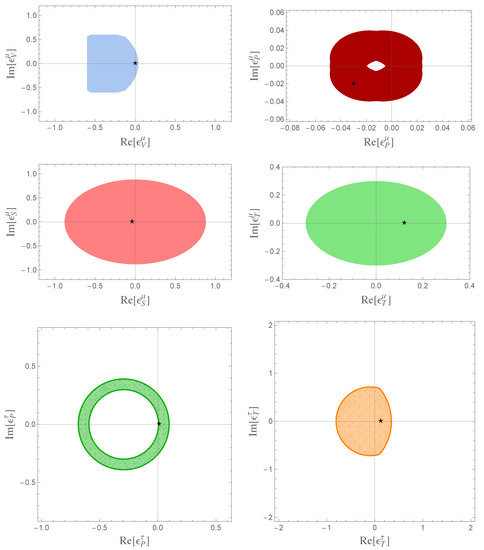
Figure 2.
Allowed regions (at CL) for the couplings and , (first row plots), and (second row plots). The stars are the benchmark points: , , and , with . The plots in the third row show the allowed regions for the couplings and , with the stars indicating the benchmark points , , and . The various colors indicate the different couplings.
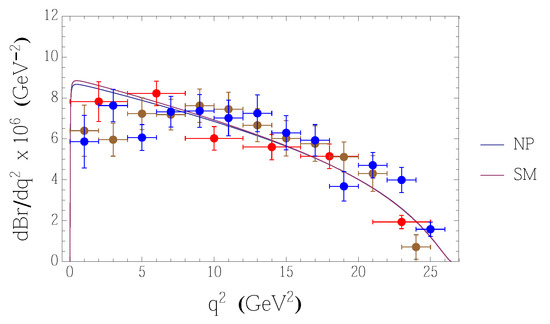
Figure 3.
distribution using the form factors in Appendix A and parameters in Table A1, in Standard Model (SM) and in New Physics (NP) at the benchmark point. The red and brown data are from Babar [58,59], the blue ones from Belle Collaboration [57].
The functions , and , which are independent of , are shown in Figure 4 for SM and NP. The bands are obtained varying the form factor parameters within their estimated ranges. Notice the zero in , absent in SM.

Figure 4.
: angular coefficient functions in Equation (5), for SM and NP at the benchmark point. The bands for SM and NP, with the colors indicated in each plot, are obtained varying the form factor parameters within the estimated ranges. A zero in appears in NP.
The other coefficient functions are in Figure 5, and there is a zero in not present in SM. The function in Figure 6 vanishes in SM, and is only sensitive to the imaginary part of the NP couplings. For the modes, the angular functions are in Figure 7 and Figure 8, and also for this mode has a zero in NP, not in SM.

Figure 5.
: angular coefficient functions (left), (middle) and (right).

Figure 6.
: angular coefficient function in NP at the benchmark point.

Figure 7.
mode: angular coefficient functions in Equation (5). The bands for SM and NP, with colors indicated in each plot, are obtained varying the form factor parameters.

Figure 8.
: angular coefficient functions (left), (middle), (right).
Let us consider the ratios
and . is form factor independent in SM. In NP it is still form factor independent in the Large Energy Limit, since and depend on . As shown in Figure 9, the ratio (7) has a zero in NP, not in SM, whose position depends only on with a small form factor effect. In the Large Energy Limit we have

Figure 9.
Ratio in (7) for (left) and (right). The dashed lines are the Large Energy result (extrapolated to the full range).
Analogously, for the channel (for considering ) we have:
The positions of the zeros in two modes are related, and their measurement would provide access to the tensor operator.
The function , shown for SM and NP in the right panel of Figure 5, is sensitive to . Different possibilities can be envisaged [44]:
(1) If there is no NP (), has no zero (right panel of Figure 5).
(2) For NP with and , has a zero at whose measurement would determine . We show in the left panel of Figure 10 in the region where the zero is present, and versus in the middle panel of the same figure.

Figure 10.
mode: (left), and position of the zero varying with (middle panel) and with (right).
(3) For NP with and , has a zero if , its position has a form factor dependence (right panel of Figure 10).
(4) Finally, if there is NP with both and , both real and imaginary parts of and are involved, and two zeroes are possible.
Integrating the 4-dimensional distribution several observables can be constructed. The -dependent forward-backward (FB) lepton asymmetry
is given by
The transverse forward-backward (TFB) asymmetry, that is, the FB asymmetry for transversely polarized , is given by
and are shown in Figure 11 for and . In NP the zero of is shifted in the mode. is sensitive to the new operators, and in the case of it has a zero absent in SM.
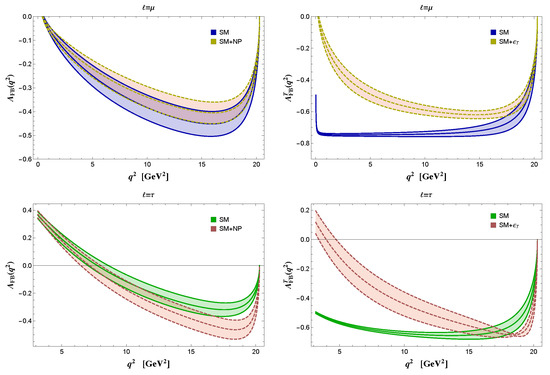
There are observables which depend on the polarization, namely the differential branching ratio for longitudinally (L) and transversely (T) polarized , as a function of or of one of the angles , : , and . They are shown in Figure 12 for and .
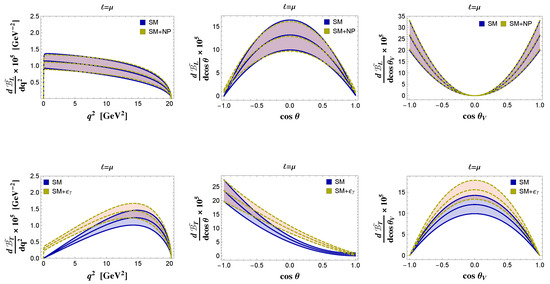

Figure 12.
mode: distributions , and (plots in the first row) and , and (plots in the second row), with for SM and NP. The plots in the third and fourth row are the analogous distributions for .
Integrating the distributions we obtain for the mode: , , and for the mode , . For we have: and . As shown in Table 1, the ratios
are modified by the NP operators in (1). The deviations are correlated, and large effects are possible varying the effective couplings in their allowed ranges (Figure 13).

Table 1.
and in Equation (14) in SM and in NP at the benchmark point.
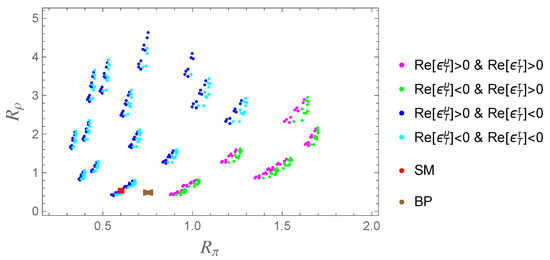
Figure 13.
vs. correlation when only the tensor operator is included in (1). The colors correspond to the different signs of and in the range of the parameter space. The red and brown points correspond to SM and NP at the benchmark point.
6.
We analyze the mode in SM and in the NP extension Equation (1) at the same benchmark points for . Exclusive hadronic B decays into have been studied at the B factories considering the dominant mode, and the measurements of the semileptonic mode are within the experimental reach, in particular at Belle II. The study of requires an assessment of the accuracy of the hadronic quantities. We use the set in Reference [60], for which an uncertainty of about is quoted. The angular coefficient functions, for the and modes and for both the polarizations are in Figure 14 and Figure 15 and in Figure 16 and Figure 17, respectively. In general, the hadronic uncertainties obscure the effect of the NP operators. Nevertheless, there are coefficient functions in which deviations from SM can be observed, namely , (Figure 14) and (Figure 16) for the channel, , (Figure 15) and , (Figure 16) for the mode. The forward/backward lepton asymmetry shows sizable deviations from SM in the case of (Figure 18).

Figure 14.
Angular coefficient functions in SM and NP (at the benchmark point) for using the form factors in Reference [60]. The band widths for SM and NP, with colors indicated in each plot, are due to the form factor uncertainty.

Figure 15.
Angular coefficient functions for (same notations as in Figure 14).

Figure 16.
Angular coefficient functions for (same notations as in Figure 14).
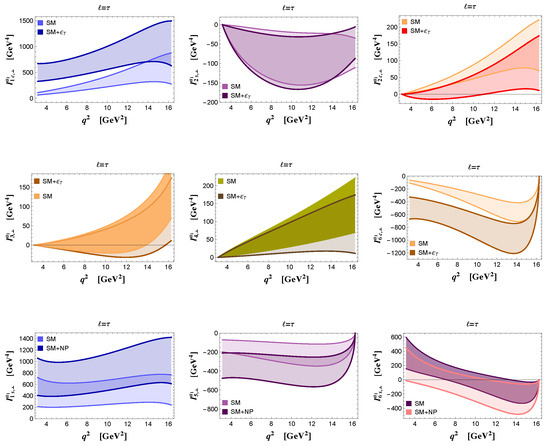
Figure 17.
Angular coefficient functions for (same notations as in Figure 14).
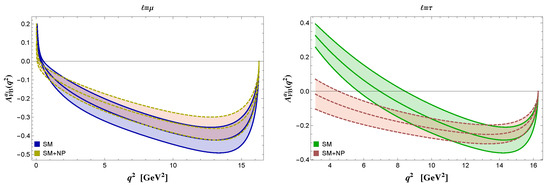
Figure 18.
: FB lepton asymmetries for (left) and (right).
For the ratio we obtain, in the SM and for NP at the benchmark point,
with individual branching fractions in SM and [60].
Summarizing the complementarity between the various B modes to the NP search, we remark that the presence of the tensor operator in (1) can be established independently of the other operators, from deviations of the observables that depend only on , for example, those involving transversely polarized and . is constrained looking at the zero of the ratios in Equations (7) and (). A correlation between the position of the zero in the and channels should be observed.
If the pseudoscalar operator is present, without other NP structures, deviations should be observed in leptonic B decays and in the semileptonic decay to , not in and modes. Determining the position of the zero in would constrain . Zeroes should not be present in . On the other hand, if the scalar operator is present without additional NP structures, deviations should be observed in semileptonic B decays to and . A zero would be present in , not in . All operators would manifest in correlated patterns of deviations.
Precise measurements of modes with final provide new important tests of LFU. and give information on the relative sign of and . The channel plays a significant role in the searches.
7. Outlook
The anomalies observed in semileptonic modes also require new precision analyses of the CKM suppressed processes. We have discussed the impact of an extended effective Hamiltonian on purely leptonic B decays, on and, in details, on and , which involve more than one hadron in the final state. For these two modes we have studied the sensitivity of the 4-dimensional angular distributionst to different NP operators. The quantum numbers of the light mesons select the contributions of the NP terms, and complementary information can be gained on the new operators in the effective Hamiltonian. Some observables have zeroes absent in SM. Comparing the modes into and , LF universality in weak transitions is probed. The error connected to the hadronic matrix elements represents a sizable uncertainty, in particular for the mode. The Large Energy Limit, in which the number of hadronic form factors is reduced, is therefore useful for the analyses.
There are exciting perspectives for NP searches in heavy hadron decays in the coming years, in particular investigating induced semileptonic B modes.
Author Contributions
All authors have equally contributed to this review. All authors have read and agreed to the published version of the manuscript.
Funding
The studies here described have been carried out within the INFN project (Iniziativa Specifica) QFT-HEP.
Acknowledgments
PC thanks Mikhail A. Ivanov and the other Organizers for invitation to give this lecture at the Helmholtz International Summer School (HISS)—Dubna International Advanced School of Theoretical Physics “Quantum Field Theory at the Limits: from Strong Fields to Heavy Quarks”, 2019.
Conflicts of Interest
The authors declare no conflict of interest.
Appendix A. Parametrization of the B→π form Factors
The form factors, in the decomposition of the weak matrix element as given in Reference [44], can be expressed in the form
with
and different parameters for each form factor. In this expression , and is chosen at . The values for in Table A1 for , satisfying the condition , are obtained using Light-Cone QCD sum rule results in the range GeV [61,62] and lattice QCD results for [63]. Other quantities used in the above analysis are the quark masses MeV (in the scheme at GeV) and GeV [53]. The decay constant is set to MeV [63].

Table A1.
Parameters of form factors in Equation (A1).
Table A1.
Parameters of form factors in Equation (A1).
References
- Lees, J.P.; Poireau, V.; Tisserand, V.; Grauges, E.; Palano, A.; Eigen, G.; Stugu, B.; Brown, D.N.; Kerth, L.T.; Kolomensky, Y.G.; et al. Evidence for an excess of B → D(*)τ−ντ decays. Phys. Rev. Lett. 2012, 109, 101802. [Google Scholar] [CrossRef] [PubMed]
- Lees, J.P.; Poireau, V.; Tisserand, V.; Grauges, E.; Palano, A.; Eigen, G.; Stugu, B.; Brown, D.N.; Kerth, L.T.; Kolomensky, Y.G.; et al. Measurement of an Excess of B → D(*)τ−ντ Decays and Implications for Charged Higgs Bosons. Phys. Rev. 2013, D88, 072012. [Google Scholar]
- Huschle, M.; Kuhr, T.; Heck, M.; Goldenzweig, P.; Abdesselam, A.; Adachi, I.; Adamczyk, K.; Aihara, H.; Al Said, S.; Arinstein, K.; et al. Measurement of the branching ratio of B → D(*)τ−ντ relative to B → D(*)ℓ−ντ decays with hadronic tagging at Belle. Phys. Rev. 2015, D92, 072014. [Google Scholar]
- Sato, Y.; Iijima, T.; Adamczyk, K.; Aihara, H.; Asner, D.M.; Atmacan, H.; Aushev, T.; Ayad, R.; Aziz, T.; Babu, V.; et al. Measurement of the branching ratio of B0→D*+τ−ντ relative to B0→D*+ℓ−νℓ decays with a semileptonic tagging method. Phys. Rev. 2016, D94, 072007. [Google Scholar] [CrossRef]
- Hirose, S.; Iijima, T.; Adachi, I.; Adamczyk, K.; Aihara, H.; Al Said, S.; Asner, D.M.; Atmacan, H.; Aulchenko, V.; Aushev, T.; et al. Measurement of the τ lepton polarization and R(D*) in the decay B → D*τ−ντ. Phys. Rev. Lett. 2017, 118, 211801. [Google Scholar] [CrossRef]
- Hirose, S.; Iijima, T.; Adachi, I.; Adamczyk, K.; Aihara, H.; Al Said, S.; Asner, D.M.; Atmacan, H.; Aulchenko, V.; Aushev, T.; et al. Measurement of the τ lepton polarization and R(D*) in the decay B → D*τ−ντ with one-prong hadronic τ decays at Belle. Phys. Rev. 2018, D97, 012004. [Google Scholar] [CrossRef]
- Aaij, R.; Adeva, B.; Adinolfi, M.; Affolder, A.; Ajaltouni, Z.; Akar, S.; Albrecht, J.; Alessio, F.; Alexander, M.; Ali, S.; et al. Measurement of the ratio of branching fractions (B0→D*+τ−ντ)/(B0→D*+μ−ντ). Phys. Rev. Lett. 2015, 115, 111803. [Google Scholar] [CrossRef]
- Aaij, R.; Adeva, B.; Adinolfi, M.; Ajaltouni, Z.; Akar, S.; Albrecht, J.; Alessio, F.; Alexander, M.; Albero, A.A.; Ali, S.; et al. Test of Lepton Flavor Universality by the measurement of the B0→D*−τ+ντ branching fraction using three-prong τ decays. Phys. Rev. 2018, D97, 072013. [Google Scholar] [CrossRef]
- Aaij, R.; Adeva, B.; Adinolfi, M.; Ajaltouni, Z.; Akar, S.; Albrecht, J.; Alessio, F.; Alexander, M.; Albero, A.A.; Ali, S.; et al. Measurement of the ratio of the B0→D*−τ+ντ and B0→D*−μ+νμ branching fractions using three-prong τ-lepton decays. Phys. Rev. Lett. 2018, 120, 171802. [Google Scholar] [CrossRef]
- Amhis, Y.; Banerjee, S.; Ben-Haim, E.; Bernlochner, F.; Bozek, A.; Bozzi, C.; Chrząszcz, M.; Dingfelder, J.; Duell, S.; Gersabeck, M.; et al. Averages of b-hadron, c-hadron, and τ-lepton properties as of summer 2016. Eur. Phys. J. 2017, C77, 895. [Google Scholar]
- Fajfer, S.; Kamenik, J.F.; Nisandzic, I. On the B → D*τντ Sensitivity to New Physics. Phys. Rev. 2012, D85, 094025. [Google Scholar]
- Biancofiore, P.; Colangelo, P.; De Fazio, F. On the anomalous enhancement observed in B → D(*)τντ decays. Phys. Rev. 2013, D87, 074010. [Google Scholar]
- Aaij, R.; Adeva, B.; Adinolfi, M.; Ajaltouni, Z.; Akar, S.; Albrecht, J.; Alessio, F.; Alexander, M.; Albero, A.A.; Ali, S.; et al. Measurement of the ratio of branching fractions (Bc+→J/ψτ+ντ)/(Bc+→J/ψμ+νμ). Phys. Rev. Lett. 2018, 120, 121801. [Google Scholar] [CrossRef] [PubMed]
- Dutta, R.; Bhol, A. Bc→(J/ψ,ηc)τν semileptonic decays within the standard model and beyond. Phys. Rev. 2017, D96, 076001. [Google Scholar]
- Watanabe, R. New Physics effect on Bc → J/ψτν in relation to the RD(*) anomaly. Phys. Lett. 2018, B776, 5. [Google Scholar] [CrossRef]
- Tran, C.T.; Ivanov, M.A.; Koerner, J.G.; Santorelli, P. Implications of new physics in the decays Bc→(J/ψ,ηc)τν. Phys. Rev. 2018, D97, 054014. [Google Scholar] [CrossRef]
- Leljak, D.; Melic, B.; Patra, M. On lepton flavour universality in semileptonic Bc → ηc, J/ψ decays. JHEP 2019, 5, 094. [Google Scholar]
- Aaij, R.; Adeva, B.; Adinolfi, M.; Ajaltouni, Z.; Akar, S.; Albrecht, J.; Alessio, F.; Alexander, M.; Albero, A.A.; Ali, S.; et al. Search for lepton-universality violation in B+→K+ℓ+ℓ− decays. Phys. Rev. Lett. 2019, 122, 191801. [Google Scholar]
- Aaij, R.; Adeva, B.; Adinolfi, M.; Ajaltouni, Z.; Akar, S.; Albrecht, J.; Alessio, F.; Alexander, M.; Albero, A.A.; Ali, S.; et al. Test of lepton universality with B0→K*0ℓ+ℓ− decays. JHEP 2017, 8, 055. [Google Scholar]
- Abdesselam, A.; Adachi, I.; Adamczyk, K.; Aihara, H.; Al Said, S.; Arinstein, K.; Arita, Y.; Asner, D.M.; Atmacan, H.; Ahn, J.K.; et al. Test of lepton flavor universality in B → K*ℓ+ℓ− decays at Belle. arXiv 2019, arXiv:hep-ex/1904.02440. [Google Scholar]
- Aaij, R.; Adeva, B.; Adinolfi, M.; Ajaltouni, Z.; Akar, S.; Albrecht, J.; Alessio, F.; Alexander, M.; Albero, A.A.; Ali, S.; et al. Test of lepton universality with Λb0→pK−ℓ+ℓ− decays. arXiv 2019, arXiv:hep-ex/1912.08139. [Google Scholar]
- Bifani, S.; Descotes-Genon, S.; Romero Vidal, A.; Schune, M.H. Review of Lepton Universality tests in B decays. J. Phys. 2019, G46, 023001. [Google Scholar] [CrossRef]
- Lees, J.P.; Poireau, V.; Tisserand, V.; Grauges, E.; Palano, A.; Eigen, G.; Stugu, B.; Brown, D.N.; Kerth, L.T.; Kolomensky, Y.G.; et al. A test of heavy quark effective theory using a four-dimensional angular analysis of B → D*ℓ−νℓ. arXiv 2019, arXiv:hep-ex/1903.10002. [Google Scholar]
- Waheed, E.; Urquijo, P.; Ferlewicz, D.; Adachi, I.; Adamczyk, K.; Ahn, J.K.; Aihara, H.; Al Said, S.; Arinstein, K.; Arita, Y.; et al. Measurement of CKM Matrix Element |Vcb| from B → D*+ℓ−νℓ. arXiv 2018, arXiv:hep-ex/1809.03290. [Google Scholar]
- Aaij, R.; Adeva, B.; Adinolfi, M.; Ajaltouni, Z.; Akar, S.; Albrecht, J.; Alessio, F.; Alexander, M.; Albero, A.A.; Ali, S.; et al. Measurement of |Vcb| with Bs0→Ds(*)−μ+νμ decays. arXiv 2020, arXiv:hep-ex/2001.03225. [Google Scholar]
- Jaiswal, S.; Nandi, S.; Patra, S.K. Extraction of |Vcb| from B → D(*)ℓνℓ and the Standard Model predictions of R(D(*)). JHEP 2017, 12, 060. [Google Scholar] [CrossRef]
- Bigi, D.; Gambino, P.; Schacht, S. A fresh look at the determination of |Vcb| from B → D*ℓν. Phys. Lett. 2017, B769, 441. [Google Scholar] [CrossRef]
- Grinstein, B.; Kobach, A. Model-Independent Extraction of |Vcb| from B → D*ℓν. Phys. Lett. 2017, B771, 359. [Google Scholar] [CrossRef]
- Gambino, P.; Jung, M.; Schacht, S. The Vcb puzzle: An update. Phys. Lett. 2019, B795, 386–390. [Google Scholar] [CrossRef]
- Colangelo, P.; De Fazio, F. Tension in the inclusive versus exclusive determinations of |Vcb|: A possible role of new physics. Phys. Rev. 2017, D95, 011701. [Google Scholar] [CrossRef]
- Alonso, R.; Kobach, A.; Martin Camalich, J. New physics in the kinematic distributions of B → D(*)τ−(→ℓ−νℓντ)ντ. Phys. Rev. 2016, D94, 094021. [Google Scholar] [CrossRef]
- Ligeti, Z.; Papucci, M.; Robinson, D.J. New Physics in the Visible Final States of B → D(*)τν. JHEP 2017, 1, 083. [Google Scholar] [CrossRef]
- Alok, A.K.; Kumar, D.; Kumbhakar, S.; Sankar, S.U. D* polarization as a probe to discriminate new physics in B → D*τν. Phys. Rev. 2017, D95, 115038. [Google Scholar] [CrossRef]
- Colangelo, P.; De Fazio, F. Scrutinizing B → D*(Dπ)ℓ−νℓ and B → D*(Dγ)ℓ−νℓ in search of new physics footprints. JHEP 2018, 6, 082. [Google Scholar] [CrossRef]
- Becirevic, D.; Fedele, M.; Nisandzic, I.; Tayduganov, A. Lepton Flavor Universality tests through angular observables of B → D(*)ℓν decay modes. arXiv 2019, arXiv:hep-ph/1907.02257. [Google Scholar]
- Chen, C.H.; Nam, S.H. Left-right mixing on leptonic and semileptonic b → u decays. Phys. Lett. 2008, B666, 462–466. [Google Scholar] [CrossRef]
- Buras, A.J.; Gemmler, K.; Isidori, G. Quark flavour mixing with right-handed currents: An effective theory approach. Nucl. Phys. 2011, B843, 107. [Google Scholar] [CrossRef]
- Crivellin, A. Effects of right-handed charged currents on the determinations of |V(ub)| and |V(cb)|. Phys. Rev. 2010, D81, 031301. [Google Scholar]
- Crivellin, A.; Pokorski, S. Can the differences in the determinations of Vub and Vcb be explained by New Physics? Phys. Rev. Lett. 2015, 114, 011802. [Google Scholar] [CrossRef]
- Bernlochner, F.U.; Ligeti, Z.; Turczyk, S. New ways to search for right-handed current in B→ρℓν decay. Phys. Rev. 2014, D90, 094003. [Google Scholar] [CrossRef]
- Bernlochner, F.U. B → πτντ decay in the context of type II 2HDM. Phys. Rev. 2015, D92, 115019. [Google Scholar]
- Blanke, M.; Crivellin, A.; Kitahara, T.; Moscati, M.; Nierste, U.; Nisandzic, I. Addendum: “Impact of polarization observables and Bc → τν on new physics explanations of the b → cτν anomaly”. arXiv 2019, arXiv:hep-ph/1905.08253. [Google Scholar] [CrossRef]
- Banelli, G.; Fleischer, R.; Jaarsma, R.; Tetlalmatzi-Xolocotzi, G. Decoding (Pseudo)-Scalar Operators in Leptonic and Semileptonic B Decays. Eur. Phys. J. 2018, C78, 911. [Google Scholar] [CrossRef] [PubMed]
- Colangelo, P.; De Fazio, F.; Loparco, F. Probing New Physics with B → ρ(770)ℓ−νℓ and B → a1(1260)ℓ−νℓ. Phys. Rev. 2019, D100, 075037. [Google Scholar] [CrossRef]
- Buchmuller, W.; Wyler, D. Effective Lagrangian Analysis of New Interactions and Flavor Conservation. Nucl. Phys. 1986, B268, 621. [Google Scholar] [CrossRef]
- Cirigliano, V.; Jenkins, J.; Gonzalez-Alonso, M. Semileptonic decays of light quarks beyond the Standard Model. Nucl. Phys. 2010, B830, 95. [Google Scholar] [CrossRef]
- Jung, M.; Straub, D.M. Constraining new physics in b → cℓν transitions. JHEP 2019, 1, 009. [Google Scholar] [CrossRef]
- Celis, A.; Jung, M.; Li, X.Q.; Pich, A. Scalar contributions to b → c(u)τν transitions. Phys. Lett. 2017, B771, 168. [Google Scholar] [CrossRef]
- Leljak, D.; Melic, B. |Vub| determination and testing of lepton flavour universality in semileptonic Bc → D(*) decays. arXiv 2019, arXiv:hep-ph/1909.01213. [Google Scholar] [CrossRef]
- Aaij, R.; Adeva, B.; Adinolfi, M.; Ajaltouni, Z.; Akar, S.; Albrecht, J.; Alessio, F.; Alexander, M.; Albero, A.A.; Ali, S.; et al. Determination of the quark coupling strength |Vub| using baryonic decays. Nat. Phys. 2015, 11, 743–747. [Google Scholar]
- Charles, J.; Le Yaouanc, A.; Oliver, L.; Pene, O.; Raynal, J.C. Heavy to light form-factors in the heavy mass to large energy limit of QCD. Phys. Rev. 1999, D60, 014001. [Google Scholar]
- Beneke, M.; Feldmann, T. Symmetry breaking corrections to heavy to light B meson form-factors at large recoil. Nucl. Phys. 2001, B592, 3. [Google Scholar] [CrossRef]
- Tanabashi, M.; Hagiwara, K.; Hikasa, K.; Nakamura, K.; Sumino, Y.; Takahashi, F.; Tanaka, J.; Agashe, K.; Aielli, G.; Amsler, C. Review of Particle Physics. Phys. Rev. 2018, D98, 030001. [Google Scholar] [CrossRef]
- Sibidanov, A.; Varvell, K.E.; Adachi, I.; Aihara, H.; Al Said, S.; Asner, D.M.; Aushev, T.; Ayad, R.; Babu, V.; Badhrees, I.; et al. Search for B−→μ−νμ Decays at the Belle Experiment. Phys. Rev. Lett. 2018, 121, 031801. [Google Scholar] [CrossRef] [PubMed]
- Hamer, P.; Frey, A.; Abdesselam, A.; Adachi, I.; Aihara, H.; Al Said, S.; Arinstein, K.; Asner, D.M.; Aushev, T.; Ayad, R.; et al. Search for B0→π−τ+ντ with hadronic tagging at Belle. Phys. Rev. 2016, D93, 032007. [Google Scholar]
- Bharucha, A.; Straub, D.M.; Zwicky, R. B → Vℓ+ℓ− in the Standard Model from light-cone sum rules. JHEP 2016, 8, 098. [Google Scholar] [CrossRef]
- Ha, H.; Won, E.; Adachi, I.; Aihara, H.; Aziz, T.; Bakich, A.M.; Balagura, V.; Barberio, E.; Bay, A.; Belous, K.; et al. Measurement of the decay B0→π−ℓ+ν and determination of |Vub|. Phys. Rev. 2011, D83, 071101. [Google Scholar]
- Del Amo Sanchez, P.; Lees, J.P.; Poireau, V.; Prencipe, E.; Tisserand, V.; Garra Tico, J.; Grauges, E.; Martinelli, M.; Milanes, D.A.; Palano, A.; et al. Measurement of the B0→πℓℓ+ν and B+→η(′)ℓ+ν Branching Fractions, the B0→π−ℓ+ν and B+→ηℓ+ν Form-Factor Shapes, and Determination of |Vub|. Phys. Rev. 2011, D83, 052011. [Google Scholar]
- Lees, J.P.; Poireau, V.; Tisserand, V.; Grauges, E.; Palano, A.; Eigen, G.; Stugu, B.; Brown, D.N.; Kerth, L.T.; Kolomensky, Y.G.; et al. Branching fraction and form-factor shape measurements of exclusive charmless semileptonic B decays, and determination of |Vub|. Phys. Rev. 2012, D86, 092004. [Google Scholar]
- Li, R.H.; Lu, C.D.; Wang, W. Transition form factors of B decays into p-wave axial-vector mesons in the perturbative QCD approach. Phys. Rev. 2009, D79, 034014. [Google Scholar]
- Sentitemsu Imsong, I.; Khodjamirian, A.; Mannel, T.; van Dyk, D. Extrapolation and unitarity bounds for the B → π form factor. JHEP 2015, 2, 126. [Google Scholar] [CrossRef]
- Khodjamirian, A.; Rusov, A.V. Bs → Kℓνℓ and B(s)→π(K)ℓ+ℓ− decays at large recoil and CKM matrix elements. JHEP 2017, 8, 112. [Google Scholar] [CrossRef]
- Aoki, S.; Aoki, Y.; Becirevic, D.; Blum, T.; Colangelo, G.; Collins, S.; Morte, M.D.; Dimopoulos, P.; Dürr, S.; Fukaya, H.; et al. FLAG Review 2019. arXiv 2019, arXiv:hep-lat/1902.08191. [Google Scholar] [CrossRef]
© 2020 by the authors. Licensee MDPI, Basel, Switzerland. This article is an open access article distributed under the terms and conditions of the Creative Commons Attribution (CC BY) license (http://creativecommons.org/licenses/by/4.0/).